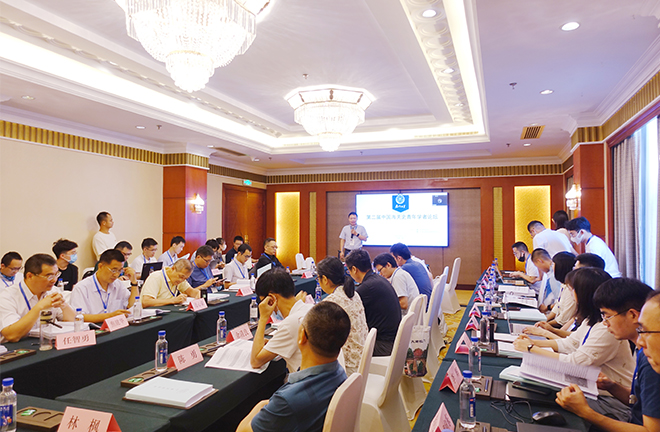Seminar probes history of customs

Scholars exchange views on customs history at the seminar. Photo: CSST
XIAMEN—Entering the new century, with the emergence of massive research archives and materials, Chinese customs history has seen a new research upsurge, attracting the attention of the younger generation of scholars. At the Second Forum for Young Scholars of Chinese Customs History in Xiamen, Fujian Province, on Sept. 3–4, young scholars shared their latest research achievements and experiences.
Disciplinary development
Currently, scholars mainly carry out thematic research on customs history. According to Shui Haigang, a professor from the Department of History and executive deputy director of the Research Center for Chinese Customs History at Xiamen University, the field of ancient Chinese customs has achieved fruitful research results, ranging from historical land border gates, tea and horse trading offices, quechang [trading markets], shibosi [trading-ship offices], duxiangguan [a tariff supervising bureau] in the Yuegang Port, or Moon Harbor in Zhangzhou, Fujian, and customs in the early and middle Qing era (1644–1911). The related systems, organizations, spatial distribution, historical functions, and influence have all been included in the research vision.
When it comes to the status of customs history in Chinese academia, we have to mention Chen Shiqi, a professor at Xiamen University, said Zhang Zhiyun, a professor from the Department of History at the School of Humanities at Shanghai Jiao Tong University. Chen devoted himself to searching for customs historical data and founded the Research Center for Chinese Customs History at Xiamen University, which focuses on the customs system. Later, Wu Songdi, a professor from the Center for Historical Geographical Studies at Fudan University, after finding the Chinese customs publications collected by John King Fairbank at Harvard University, founded the International Research Center for Customs History and Customs Literature at Fudan University in 2016 in order to study the economic geography of modern China based on trade data. In recent years, a host of scholars from Sun Yat-sen University, Central China Normal University, and Shanghai University have been engaging in the field of customs history.
In 2003, the History of the Chinese Maritime Customs Service project, led by Robert Bickers, a professor of history at the University of Bristol in the UK, started to sort a large number of customs archives and customs publications collected in the Second Historical Archives of China. In the same year, Wu discovered and began to sort out massive modern customs publications, collected by Harvard University, which had not attracted enough attention from domestic scholars.
Dynamism from young scholars
Wu Lingfei, an associate professor from the Department of History at Xiamen University, said that with the development of domestic archives, the compilation of overseas materials, and the application of new technologies such as geographic information systems, customs history research continues to draw the attention of young scholars. Under the guidance of senior scholars, more young scholars with multi-disciplinary backgrounds have joined in the field. The research achievements of modern customs have been emerging continuously since the turn of the century, making breakthroughs from themes, perspectives, and methods.
Wang Zhe, a young scholar from the Center for Historical Geographical Studies at Fudan University, noted the trend of diversified development in terms of research topics and methods among young scholars. He regarded modern customs as a “probe” to understand the economic development and economic geography pattern of modern China.
In view of some obscure problems in the field of modern economic history, such as the segmentation of the modern domestic market and the boundary of the modern regional market, we make use of the data of inter-port trade and transit dues [beginning with the Treaty of Tientsin in 1858 and abolished in 1931] in modern customs statistics, conducting research based on solid quantitative data and beyond the accuracy of previous studies, Wang added.
Comparing the number of participants, the quality of submissions, and the orientation of topic selection of the first and second forums, Shui noticed the obvious new look and new atmosphere among young scholars. In terms of historical data excavation, research methods, and topic selection, they mostly focus on the compilation and use of customs publications, customs trade statistics, and customs archives in modern China. At the same time, they make a comprehensive use of historical literature analysis, quantitative methods, and historical geography research tools and means to explore China’s modern customs alone, customs and China’s modern taxation and finance, politics and society, knowledge production and dissemination, etc.
In recent years, young scholars have conducted in-depth research on cross-border and trans-disciplinary issues based on customs history, Zhang said. For instance, they delve into opera, Southeast Asian colonies, or medical theory, rather than focusing solely on customs itself. In addition, the foreign language advantage of the younger generation is highlighted when excavating historical materials. They have a more comprehensive grasp of English historical materials, as well as French, Japanese, Korean, and historical materials in other languages.
In the opinion of Shui, academia views Chinese customs as an organic component of Chinese history, but general, comprehensive, and in-depth research has not yet come out. Previous research vision concentrated on social politics, economy, and external relations in a certain period. This limitation restricts the accurate grasp and profound understanding of the diversified historical forms of Chinese customs, which leaves academic space for young scholars to progress towards.
Edited by YANG LANLAN
